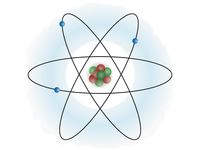One Electron At A Time: Scientists Close In On Quantum Computing
Ann Arbor (MI) - Researchers at the University of Michigan, U.S. Naval Research Laboratory and the University of California at San Diego have made a big step towards quantum computing by trapping the spin of one electron in critical dark state - at rates of about 1 GHz.
Quantum computing remains one of those science-fiction topics that remain a mystery to most of us. There is this feeling that quantum computing will replace computer technologies as we know it today with monstrous computing power for applications we cannot imagine yet. But if you look to computer science and physics labs across the globe, you will discover a growing effort to solve the mysteries behind quantum computing, with new ideas trying to piece together a huge quantum computing puzzle surfacing almost on a weekly basis.
Researchers at University of Michigan, U.S. Naval Research Laboratory and the University of California at San Diego believe they have created on key puzzle piece by demonstrating the quantum state of a solid-state qubit at rates of about 1 GHz.
Physics professor Duncan Steel, doctoral student Xiaodong Xu and their colleagues used lasers to stably trap the spin of one electron confined in a single semiconductor quantum dot, which compares to functionality of a transistor in a traditional computer chip. The spin was trapped in a so-called "dark state", a state in which scientists can arbitrarily and reliably adjust the amount of 0 and 1 the qubit represents, since no light is absorbed. Any reaction to light could potentially destroy the coherence and impact information stored in the qubit.
A conventional bit can be a 0 or a 1. A quantum bit, or qubit, can be both at the same time. Until now, scientists couldn’t stabilize that duality. The scientists believe they can use lasers to achieve "fundamental steps" toward programming the qubit. Researchers generally believe that it is the duality of the qubit that may enable much faster and much more secure computers sometime in the future. Steel said that quantum computers will enable the development of code that would be "impossible to crack" with conventional computers.
The scientist noted that spin is an intrinsic property of the electron that isn’t a real rotation. He compares it to the magnetic poles, explaining that electrons are said "to have spin up or down". While traditional bits have 0 or 1 values, the up and down spin directions are the equivalent of 0s and 1s in conventional computing.
Get Tom's Hardware's best news and in-depth reviews, straight to your inbox.

Wolfgang Gruener is an experienced professional in digital strategy and content, specializing in web strategy, content architecture, user experience, and applying AI in content operations within the insurtech industry. His previous roles include Director, Digital Strategy and Content Experience at American Eagle, Managing Editor at TG Daily, and contributing to publications like Tom's Guide and Tom's Hardware.
-
cah027 Actually I find that it barely entertaining its so infantile. Why. I have two Quantum Computers built by me in my lab down in the basement of my home. Yes.... you see... I finally had to tell someone !!!! Moooaahahahaaaaa (evil laugh) ......Reply -
Evolution2001 TormentThey can't actually be in both observable states at once. That's not how QM works.Might have something to do with quantum entanglement, as such that knowing the state of one bit, you can 'observe' the known state of the other.Reply
...or not...
-
V3NOM Evolution2001Might have something to do with quantum entanglement, as such that knowing the state of one bit, you can 'observe' the known state of the other....or not...um yes...mhm... anyone here speak english?Reply -
In QM everything is a probability, so until the spin of the electron is measured it has equal, 50-50 probability of being in both spin states. But I agree it should have said the electron has an equal chance of having either spin and not "A quantum bit, or qubit, can be both at the same time."Reply
-
in short, you can never be 100% sure in quantum mechanics. refer to the uncertaintny principle.Reply
Nature itself doesnt know for sure.
Looking at an electron changes its behavior. Refer to the double slit experiment.
In quantum mechanics, an electron or any particle can be in multiple places at the same time and can even to some extent move backwards in time to change its current state. Also multiple places at the same time doesnt mean the same info is stored on it. Thus yes they could be observable in both states, however, following the quantum uncertainty principle. we can never be sure.
Its fun stuff. Not too hard, just needs worded simple.
And about entanglement... well once two particles are entangled and share their quantum state, both show opposite behaviors. Eg, one rotates clockwise, the other will rotate counterclockwise. That said. If the entangled particles form a system, then yes you have one example of both states at once. Until you look at it.. xD
